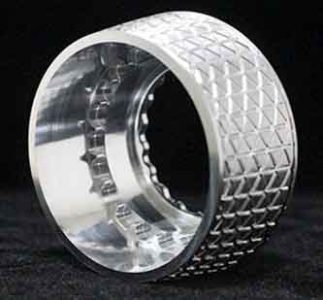CNC ಯಂತ್ರದ ಸಮಯದಲ್ಲಿ ಅಲ್ಯೂಮಿನಿಯಂ ಮಿಶ್ರಲೋಹದ ಭಾಗಗಳ ವಿರೂಪಕ್ಕೆ ಹಲವು ಕಾರಣಗಳಿವೆ, ಮತ್ತು ಕಾರ್ಯಾಚರಣೆಯ ವಿಧಾನವು ನಿಜವಾದ ಕಾರ್ಯಾಚರಣೆಯಲ್ಲಿನ ಕಾರಣಗಳಲ್ಲಿ ಒಂದಾಗಿದೆ. ಮುಂದೆ, ಅಲ್ಯೂಮಿನಿಯಂ ಮಿಶ್ರಲೋಹ ಭಾಗಗಳ ಸಿಎನ್ಸಿ ಯಂತ್ರ ತಯಾರಕರು ಅಲ್ಯೂಮಿನಿಯಂ ಮಿಶ್ರಲೋಹ ಭಾಗಗಳ ಸಂಸ್ಕರಣೆಯ ಕಾರ್ಯಾಚರಣಾ ಕೌಶಲ್ಯಗಳನ್ನು ಸಂಕ್ಷಿಪ್ತವಾಗಿ ಪರಿಚಯಿಸುತ್ತಾರೆ.
(1) For parts with large milling allowances, in order to have better heat dissipation conditions during processing and avoid heat concentration, symmetrical processing should be used during processing. 90 ಎಂಎಂ ದಪ್ಪದ ಅಲ್ಯೂಮಿನಿಯಂ ಶೀಟ್ ಇದ್ದರೆ ಅದನ್ನು 60 ಎಂಎಂಗೆ ಯಂತ್ರದ ಅಗತ್ಯವಿದೆ, if the other side is milled immediately after milling all the margins on one side, and the final size is processed at one time, the flatness can only reach 5mm; If symmetrical processing with repeated feeds on two sides is used, ಪ್ರತಿ ಬದಿಯನ್ನು ಅಂತಿಮ ಗಾತ್ರಕ್ಕೆ ಎರಡು ಬಾರಿ ಸಂಸ್ಕರಿಸಲಾಗುತ್ತದೆ, which can ensure a flatness of 0.3mm.
(2) Reduce cutting force and cutting heat by changing the cutting amount. Among the three elements of cutting volume, cutting thickness has a great influence on cutting force. If the milling allowance is too large, ಒಂದು ಪಾಸ್ನ ಕತ್ತರಿಸುವ ಬಲವು ತುಂಬಾ ದೊಡ್ಡದಾಗಿದೆ, ಇದು ಭಾಗಗಳನ್ನು ಮಾತ್ರ ವಿರೂಪಗೊಳಿಸುವುದಿಲ್ಲ, ಆದರೆ ಯಂತ್ರ ಉಪಕರಣದ ಸ್ಪಿಂಡಲ್ನ ಬಿಗಿತದ ಮೇಲೆ ಪರಿಣಾಮ ಬೀರುತ್ತದೆ ಮತ್ತು ಉಪಕರಣದ ಬಾಳಿಕೆಯನ್ನು ಕಡಿಮೆ ಮಾಡುತ್ತದೆ. If the cutting thickness is reduced, ಉತ್ಪಾದನಾ ದಕ್ಷತೆಯು ಬಹಳವಾಗಿ ಕಡಿಮೆಯಾಗುತ್ತದೆ. ಆದಾಗ್ಯೂ, high-speed milling is used in CNC machining, which can overcome this problem. While reducing the cutting thickness, as long as the feed is increased correspondingly and the speed of the machine tool is increased, ಸಂಸ್ಕರಣಾ ದಕ್ಷತೆಯನ್ನು ಖಾತ್ರಿಪಡಿಸುವಾಗ ಕತ್ತರಿಸುವ ಬಲವನ್ನು ಕಡಿಮೆ ಮಾಡಬಹುದು.
(3) If there are multiple cavities on the aluminum plate part, it is not advisable to use a cavity-by-cavity sequential processing method during processing, as this will easily cause uneven stress and deformation of the parts. ಬಹು-ಪದರದ ಸಂಸ್ಕರಣೆಯನ್ನು ಅಳವಡಿಸಲಾಗಿದೆ, and each layer is processed to all cavities at the same time as much as possible, and then the next layer is processed to make the parts evenly stressed and reduce deformation.
4) The thin-walled aluminum alloy workpiece is deformed due to the clamping of the fixture during CNC machining. Even finishing is unavoidable. ವರ್ಕ್ಪೀಸ್ನ ವಿರೂಪವನ್ನು ಕಡಿಮೆ ಮಾಡಲು, you can loosen the clamp before the finishing process reaches the final size, ಆದ್ದರಿಂದ ವರ್ಕ್ಪೀಸ್ ಅನ್ನು ಅದರ ಮೂಲ ಆಕಾರಕ್ಕೆ ಮುಕ್ತವಾಗಿ ಮರುಸ್ಥಾಪಿಸಬಹುದು. ನಂತರ ಅದನ್ನು ವರ್ಕ್ಪೀಸ್ ಅನ್ನು ಕ್ಲ್ಯಾಂಪ್ ಮಾಡುವ ಮಟ್ಟಿಗೆ ಲಘುವಾಗಿ ಕುಗ್ಗಿಸಿ, ಇದರಿಂದ ಆದರ್ಶ ಸಂಸ್ಕರಣಾ ಪರಿಣಾಮವನ್ನು ಪಡೆಯಬಹುದು. ಸಂಕ್ಷಿಪ್ತವಾಗಿ, ಕ್ಲ್ಯಾಂಪ್ ಮಾಡುವ ಬಲದ ಕ್ರಿಯೆಯ ಬಿಂದುವು ಪೋಷಕ ಮೇಲ್ಮೈಯಲ್ಲಿ ಉತ್ತಮವಾಗಿರುತ್ತದೆ, and the clamping force should act in the direction where the rigidity of the workpiece is good. Under the premise of ensuring that the workpiece does not loosen, ಕ್ಲ್ಯಾಂಪ್ ಮಾಡುವ ಶಕ್ತಿ ಚಿಕ್ಕದಾಗಿದೆ, ಉತ್ತಮವಾದದ್ದು.
(5) The CNC cutting sequence should also be paid attention to. ಒರಟು ಯಂತ್ರವು ಯಂತ್ರದ ದಕ್ಷತೆಯ ಸುಧಾರಣೆ ಮತ್ತು ಪ್ರತಿ ಯೂನಿಟ್ ಸಮಯಕ್ಕೆ ತೆಗೆಯುವ ದರದ ಅನ್ವೇಷಣೆಯನ್ನು ಒತ್ತಿಹೇಳುತ್ತದೆ. Rough machining can generally be upside milling. ಅದು, ಖಾಲಿ ಮೇಲ್ಮೈಯಲ್ಲಿರುವ ಹೆಚ್ಚುವರಿ ವಸ್ತುಗಳನ್ನು ವೇಗವಾಗಿ ಮತ್ತು ಕಡಿಮೆ ಸಮಯದಲ್ಲಿ ತೆಗೆದುಹಾಕಲಾಗುತ್ತದೆ, ಮತ್ತು ಮುಗಿಸಲು ಅಗತ್ಯವಾದ ಜ್ಯಾಮಿತೀಯ ಬಾಹ್ಯರೇಖೆಯು ಮೂಲತಃ ರಚನೆಯಾಗುತ್ತದೆ. ಮುಕ್ತಾಯದ ಒತ್ತು ಹೆಚ್ಚಿನ ನಿಖರತೆ ಮತ್ತು ಉತ್ತಮ ಗುಣಮಟ್ಟವಾಗಿದೆ, so down milling should be used. ಏಕೆಂದರೆ ಡೌನ್ ಮಿಲ್ಲಿಂಗ್ ಸಮಯದಲ್ಲಿ ಕಟ್ಟರ್ ಹಲ್ಲುಗಳ ಕತ್ತರಿಸುವ ದಪ್ಪವು ಕ್ರಮೇಣ ಗರಿಷ್ಠದಿಂದ ಶೂನ್ಯಕ್ಕೆ ಕಡಿಮೆಯಾಗುತ್ತದೆ, ಕೆಲಸದ ಗಟ್ಟಿಯಾಗಿಸುವ ಮಟ್ಟವು ಬಹಳ ಕಡಿಮೆಯಾಗಿದೆ, ಮತ್ತು ಅದೇ ಸಮಯದಲ್ಲಿ, the degree of deformation of the parts is reduced.
(6) When CNC machining aluminum parts with cavities, ಮಿಲ್ಲಿಂಗ್ ಕಟ್ಟರ್ ನೇರವಾಗಿ ಡ್ರಿಲ್ ನಂತಹ ಭಾಗಕ್ಕೆ ಧುಮುಕುವುದನ್ನು ಬಿಡದಿರಲು ಪ್ರಯತ್ನಿಸಿ. This leads to insufficient chip holding space of the milling cutter, unsmooth chip removal, and unfavorable phenomena such as parts overheating, expansion, tool collapse, and tool breakage. ಪ್ರಥಮ, drill the hole with a milling cutter of the same size as the milling cutter or one size larger, and then use the milling cutter to mill. ಪರ್ಯಾಯವಾಗಿ, CAM ಸಾಫ್ಟ್ವೇರ್ ಅನ್ನು ಸುರುಳಿಯಾಕಾರದ ಕತ್ತರಿಸುವ ಪ್ರೋಗ್ರಾಂ ಅನ್ನು ಉತ್ಪಾದಿಸಲು ಬಳಸಬಹುದು.

ಅಲ್ಯೂಮಿನಿಯಂ ಮಿಶ್ರಲೋಹದ ಭಾಗಗಳ ಟರ್ನಿಂಗ್ ಮತ್ತು ಮಿಲ್ಲಿಂಗ್ ಕೌಶಲ್ಯಗಳು
 English
English العربية
العربية 中文(漢字)
中文(漢字) Čeština
Čeština Dansk
Dansk Nederlands
Nederlands Suomi
Suomi Français
Français Deutsch
Deutsch Italiano
Italiano 日本語
日本語 ಕನ್ನಡ
ಕನ್ನಡ 한국어
한국어 Português
Português Русский
Русский Slovenčina
Slovenčina Español
Español Svenska
Svenska Türkçe
Türkçe

